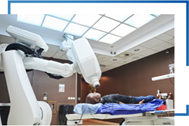7. Additional reading
Additional reading
Example Artificial Intelligence (AI)Harvard Medical School published research comparing the accuracy of machine learning systems against human pathologists in detecting breast cancer. The machine learning was 92% accurate, which is good. But humans were 96% accurate. Case closed, right? Harvard then combined the pathologists' discoveries with the scans of the machine learning systems. The accuracy soared to 99.5%. That reduces the mistakes by almost an order of magnitude (from 40 per thousand to just 5 per thousand) and represents 56,000 fewer misread breast scans per year in the U.S. alone. To accomplish this, researchers had to amass huge amounts of data from which they could train their machine learning models.It isn't just radiology; the emerging field of gene therapy maps pathologies to specific genetic mutations. This means that newly diagnosed cancer patients now routinely have their genes sequenced so oncologists can prescribe the most effective treatment. Gene therapy has advanced in part through the genetic sequencing of hundreds of thousands of humans, and in part from dramatic drops in the cost of gene sequencing. The key to both of these life-saving advances? Petabytes and petabytes of data.”[9]. |
It is worth nothing that employing AI of this type helps to bring important information to the attention of the practitioners to support them in their decision-making rather than make decisions for or instead of them. In other words, considering both, the characteristics of data-driven prediction and decision support systems and those of HCPs’ work, there is nothing to suggest that AI will replace humans in health care but will rather be complementary.
A note of caution
AI applications in health require large amounts of training data to make predictions. AI methods are narrowly focussed on a specific task and may not work well when used with data that is even slightly different from the training data. Examples from image recognition show that changing a single pixel in an image – which is completely irrelevant for the human observer – can change an algorithm’s output drastically; or images essentially showing noise are assigned a category at high confidence levels by the algorithm. One reason can be the fact that humans and machines learn how to do things in very different ways (OECD, 2019) [2] .This was exemplified by challenges posed by the COVID-19 outbreak: already at the onset of the crisis, radiologists quickly learned to recognise the typical signs of severe SARS-CoV-2 disease in the CT scans of the lungs (Drosten, 2020) [3] . To train an AI system, might take years to collect enough images and to adequately prepare and label training data, so it could start learning how to detect COVID-19 not to mention diagnosing it.
EU-funded Projects in AI4
 |
Neuro-rehabilitation assisting recovery of COVID-19 intensive care patients |
|---|
Note 1: EU-funded projects in AI https://ec.europa.eu/info/strategy/priorities-2019-2024/europe-fit-digital-age/excellence-trust-artificial-intelligence_en#eu-funded-projects-in-ai
|
For the interested: WHO published a rather detailed classification of Digital Health Interventions in 2018. This classification framework of digital health interventions (DHIs) categorises the different ways in which digital and mobile technologies are being used to support health system needs. It aims to promote an accessible and bridging language to articulate functionalities of digital health implementations. Also referred to as a taxonomy, this Classification scheme is anchored on the unit of a “digital health intervention,” which represents a discrete functionality of the digital technology to achieve health sector objectives World Health Organization. (2018). Classification of digital health interventions v1.0: a shared language to describe the uses of digital technology for health. World Health Organization. Classification of digital health interventions v1.0: a shared language to describe the uses of digital technology for health (who.int). License: CC BY-NC-SA 3.0 IGO |
[1] Data Is The New Oil -- And That's A Good Thing, Kiran Bhageshpur, Forbes Councils Member, Forbes Technology Council, COUNCIL POST (2019) https://www.forbes.com/sites/forbestechcouncil/2019/11/15/data-is-the-new-oil-and-thats-a-good-thing/
[2] OECD (2019), Health in the 21st Century: Putting Data to Work for Stronger Health Systems, OECD Health Policy Studies, OECD Publishing, Paris, https://dx.doi.org/10.1787/e3b23f8e- en.
[3] Drosten, C. (2020), Das Corona virus-update, https://www.ndr.de/nachrichten/info/podcast4684.html.